Legal Issues in Business Organizations, Tourism and Events: A Report
VerifiedAdded on 2023/06/07
|7
|1976
|142
Report
AI Summary
This report, prepared for the LFBM104 and LFTE104 courses, delves into the legal aspects of business organizations, focusing on their formation, the types available, and the resolution of legal disputes. It examines three primary business structures: sole proprietorships, partnerships, and corporations, detailing their characteristics, legal requirements, and the implications for business owners. The report also highlights the importance of business law, including company law and key legislations such as employment, competition, and consumer protection laws in the UK. Furthermore, it explores various methods for resolving disputes, with a particular emphasis on Alternative Dispute Resolution (ADR) mechanisms, such as mediation, arbitration, and negotiation, as efficient and cost-effective alternatives to court proceedings. The report concludes by underscoring the significance of understanding business law to ensure proper business conduct and protect the interests of all parties involved, including consumers. The report also references relevant books and journals to support its findings.
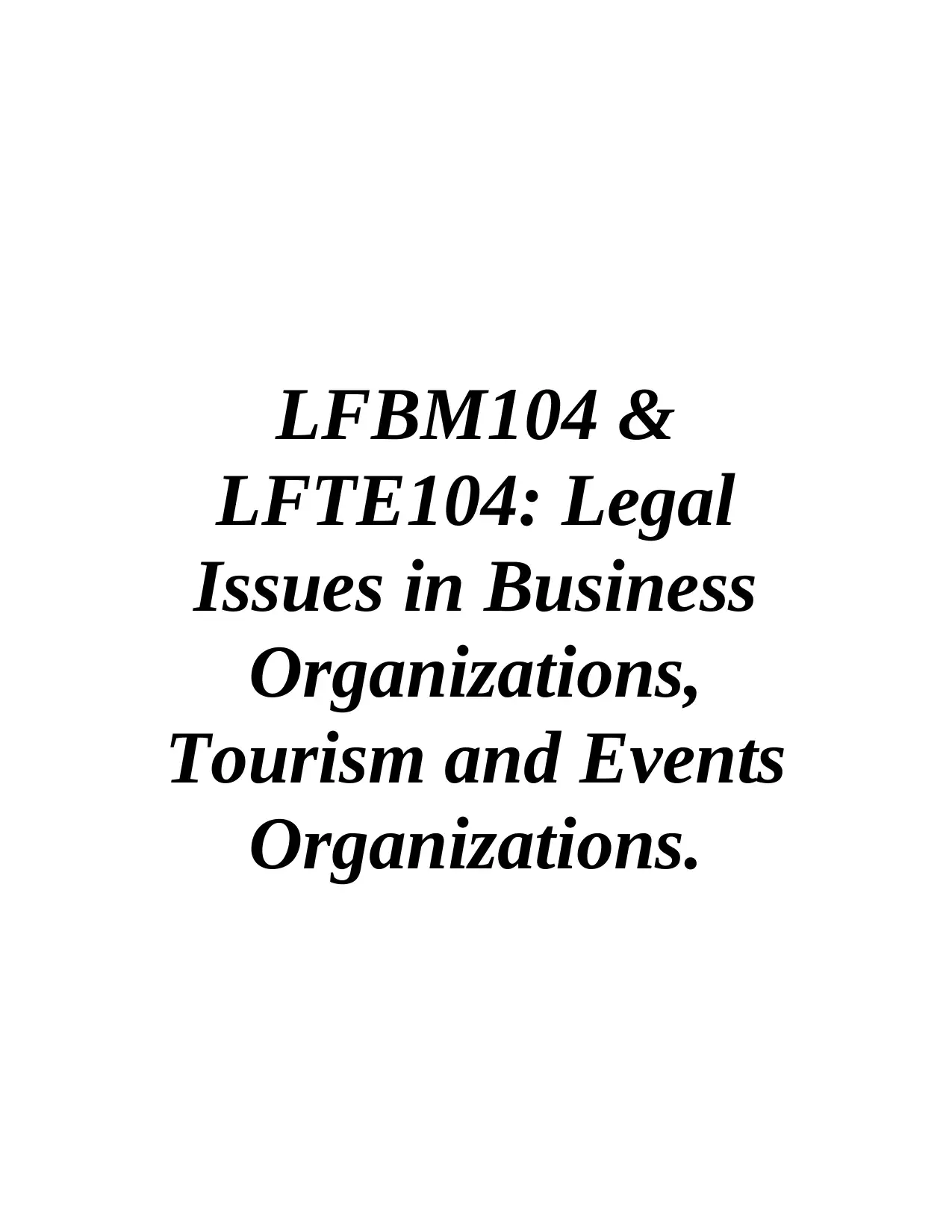
LFBM104 &
LFTE104: Legal
Issues in Business
Organizations,
Tourism and Events
Organizations.
LFTE104: Legal
Issues in Business
Organizations,
Tourism and Events
Organizations.
Paraphrase This Document
Need a fresh take? Get an instant paraphrase of this document with our AI Paraphraser
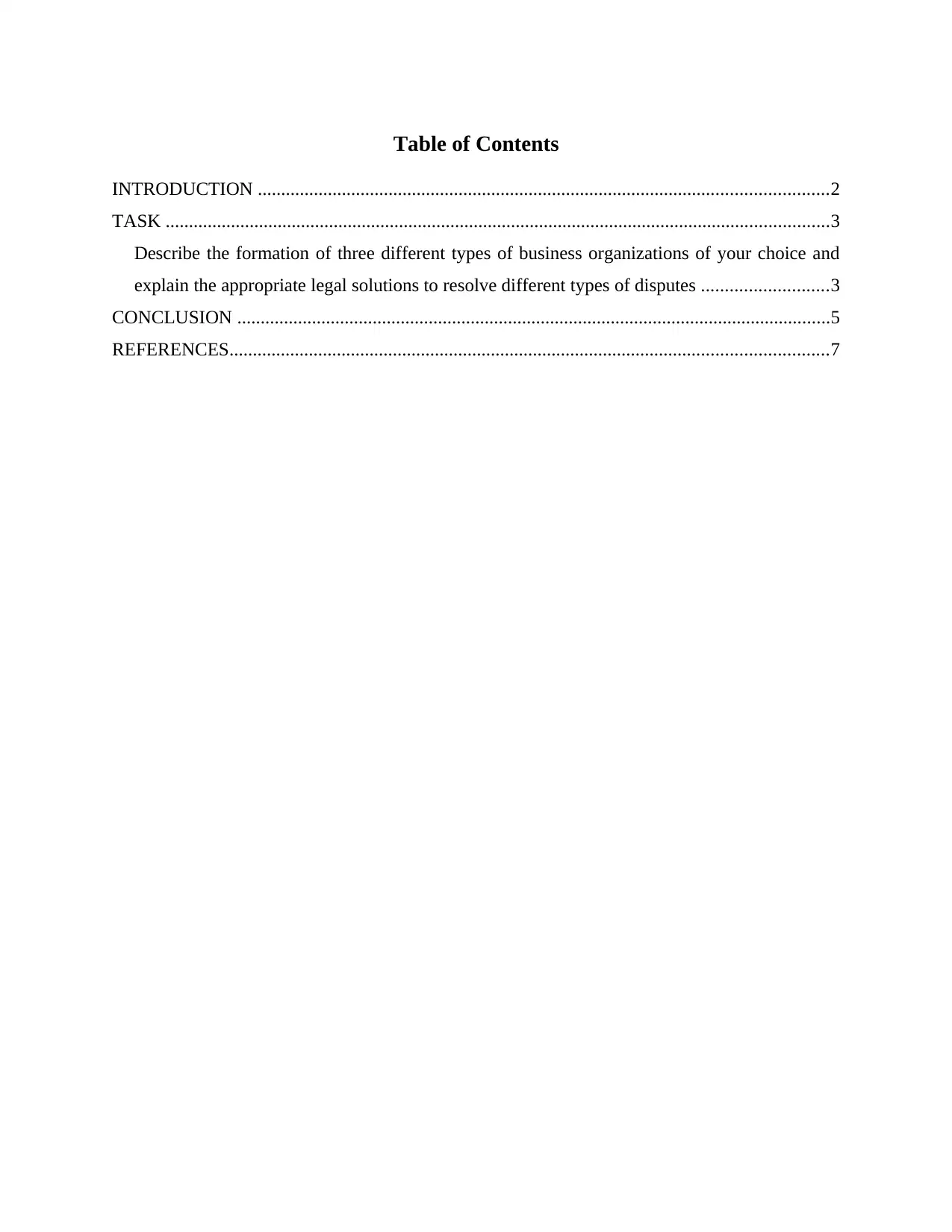
Table of Contents
INTRODUCTION ..........................................................................................................................2
TASK ..............................................................................................................................................3
Describe the formation of three different types of business organizations of your choice and
explain the appropriate legal solutions to resolve different types of disputes ...........................3
CONCLUSION ...............................................................................................................................5
REFERENCES................................................................................................................................7
INTRODUCTION ..........................................................................................................................2
TASK ..............................................................................................................................................3
Describe the formation of three different types of business organizations of your choice and
explain the appropriate legal solutions to resolve different types of disputes ...........................3
CONCLUSION ...............................................................................................................................5
REFERENCES................................................................................................................................7
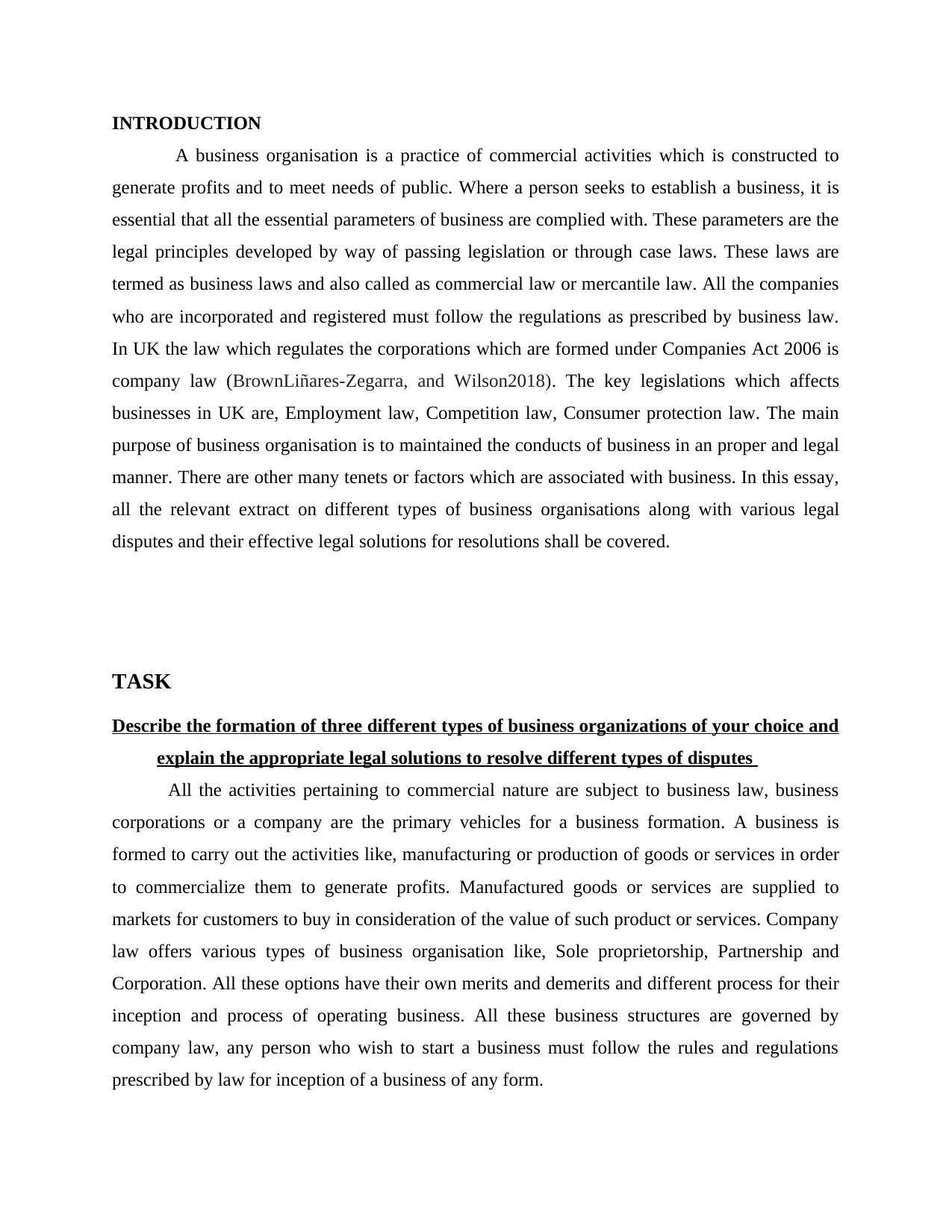
INTRODUCTION
A business organisation is a practice of commercial activities which is constructed to
generate profits and to meet needs of public. Where a person seeks to establish a business, it is
essential that all the essential parameters of business are complied with. These parameters are the
legal principles developed by way of passing legislation or through case laws. These laws are
termed as business laws and also called as commercial law or mercantile law. All the companies
who are incorporated and registered must follow the regulations as prescribed by business law.
In UK the law which regulates the corporations which are formed under Companies Act 2006 is
company law (BrownLiñares-Zegarra, and Wilson2018). The key legislations which affects
businesses in UK are, Employment law, Competition law, Consumer protection law. The main
purpose of business organisation is to maintained the conducts of business in an proper and legal
manner. There are other many tenets or factors which are associated with business. In this essay,
all the relevant extract on different types of business organisations along with various legal
disputes and their effective legal solutions for resolutions shall be covered.
TASK
Describe the formation of three different types of business organizations of your choice and
explain the appropriate legal solutions to resolve different types of disputes
All the activities pertaining to commercial nature are subject to business law, business
corporations or a company are the primary vehicles for a business formation. A business is
formed to carry out the activities like, manufacturing or production of goods or services in order
to commercialize them to generate profits. Manufactured goods or services are supplied to
markets for customers to buy in consideration of the value of such product or services. Company
law offers various types of business organisation like, Sole proprietorship, Partnership and
Corporation. All these options have their own merits and demerits and different process for their
inception and process of operating business. All these business structures are governed by
company law, any person who wish to start a business must follow the rules and regulations
prescribed by law for inception of a business of any form.
A business organisation is a practice of commercial activities which is constructed to
generate profits and to meet needs of public. Where a person seeks to establish a business, it is
essential that all the essential parameters of business are complied with. These parameters are the
legal principles developed by way of passing legislation or through case laws. These laws are
termed as business laws and also called as commercial law or mercantile law. All the companies
who are incorporated and registered must follow the regulations as prescribed by business law.
In UK the law which regulates the corporations which are formed under Companies Act 2006 is
company law (BrownLiñares-Zegarra, and Wilson2018). The key legislations which affects
businesses in UK are, Employment law, Competition law, Consumer protection law. The main
purpose of business organisation is to maintained the conducts of business in an proper and legal
manner. There are other many tenets or factors which are associated with business. In this essay,
all the relevant extract on different types of business organisations along with various legal
disputes and their effective legal solutions for resolutions shall be covered.
TASK
Describe the formation of three different types of business organizations of your choice and
explain the appropriate legal solutions to resolve different types of disputes
All the activities pertaining to commercial nature are subject to business law, business
corporations or a company are the primary vehicles for a business formation. A business is
formed to carry out the activities like, manufacturing or production of goods or services in order
to commercialize them to generate profits. Manufactured goods or services are supplied to
markets for customers to buy in consideration of the value of such product or services. Company
law offers various types of business organisation like, Sole proprietorship, Partnership and
Corporation. All these options have their own merits and demerits and different process for their
inception and process of operating business. All these business structures are governed by
company law, any person who wish to start a business must follow the rules and regulations
prescribed by law for inception of a business of any form.
⊘ This is a preview!⊘
Do you want full access?
Subscribe today to unlock all pages.

Trusted by 1+ million students worldwide
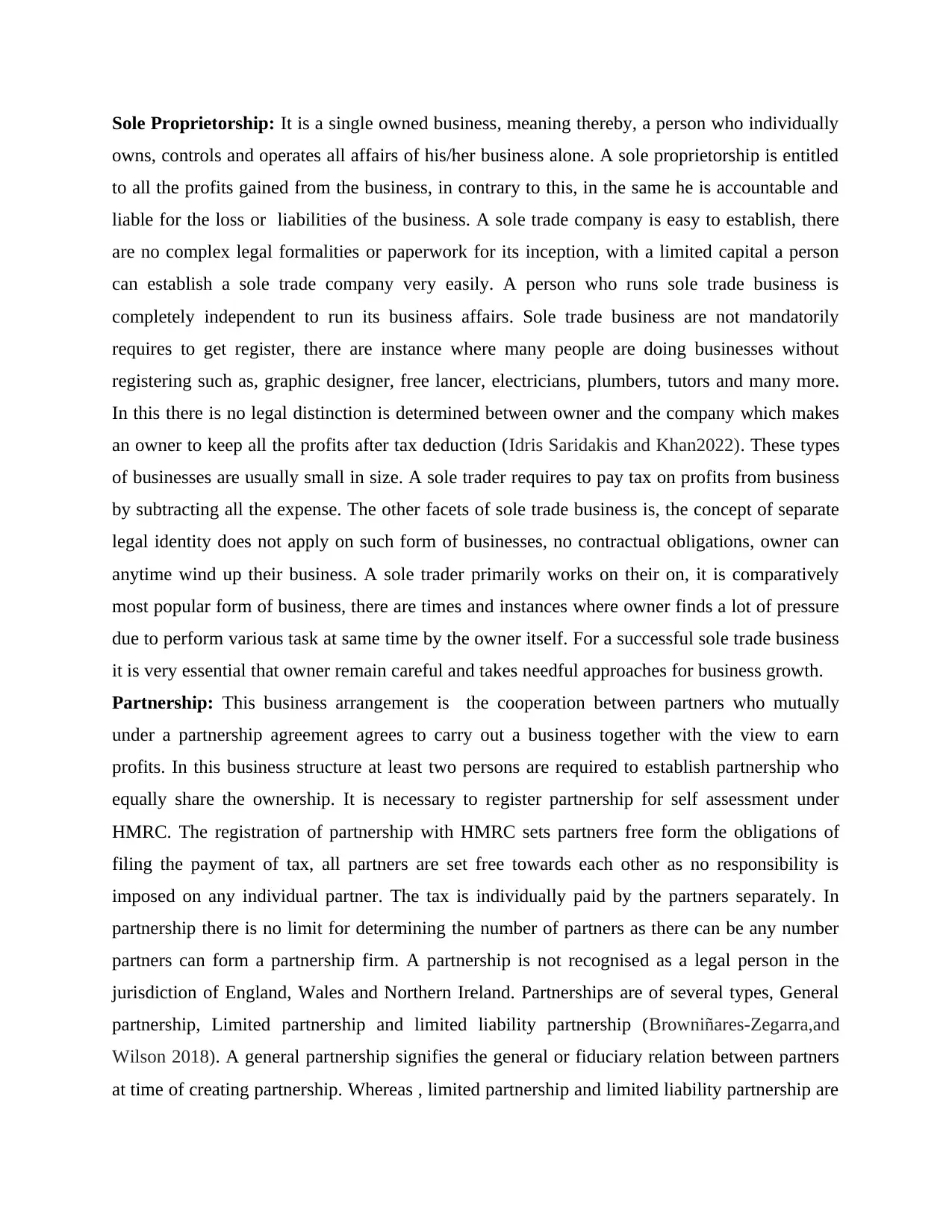
Sole Proprietorship: It is a single owned business, meaning thereby, a person who individually
owns, controls and operates all affairs of his/her business alone. A sole proprietorship is entitled
to all the profits gained from the business, in contrary to this, in the same he is accountable and
liable for the loss or liabilities of the business. A sole trade company is easy to establish, there
are no complex legal formalities or paperwork for its inception, with a limited capital a person
can establish a sole trade company very easily. A person who runs sole trade business is
completely independent to run its business affairs. Sole trade business are not mandatorily
requires to get register, there are instance where many people are doing businesses without
registering such as, graphic designer, free lancer, electricians, plumbers, tutors and many more.
In this there is no legal distinction is determined between owner and the company which makes
an owner to keep all the profits after tax deduction (Idris Saridakis and Khan2022). These types
of businesses are usually small in size. A sole trader requires to pay tax on profits from business
by subtracting all the expense. The other facets of sole trade business is, the concept of separate
legal identity does not apply on such form of businesses, no contractual obligations, owner can
anytime wind up their business. A sole trader primarily works on their on, it is comparatively
most popular form of business, there are times and instances where owner finds a lot of pressure
due to perform various task at same time by the owner itself. For a successful sole trade business
it is very essential that owner remain careful and takes needful approaches for business growth.
Partnership: This business arrangement is the cooperation between partners who mutually
under a partnership agreement agrees to carry out a business together with the view to earn
profits. In this business structure at least two persons are required to establish partnership who
equally share the ownership. It is necessary to register partnership for self assessment under
HMRC. The registration of partnership with HMRC sets partners free form the obligations of
filing the payment of tax, all partners are set free towards each other as no responsibility is
imposed on any individual partner. The tax is individually paid by the partners separately. In
partnership there is no limit for determining the number of partners as there can be any number
partners can form a partnership firm. A partnership is not recognised as a legal person in the
jurisdiction of England, Wales and Northern Ireland. Partnerships are of several types, General
partnership, Limited partnership and limited liability partnership (Browniñares-Zegarra,and
Wilson 2018). A general partnership signifies the general or fiduciary relation between partners
at time of creating partnership. Whereas , limited partnership and limited liability partnership are
owns, controls and operates all affairs of his/her business alone. A sole proprietorship is entitled
to all the profits gained from the business, in contrary to this, in the same he is accountable and
liable for the loss or liabilities of the business. A sole trade company is easy to establish, there
are no complex legal formalities or paperwork for its inception, with a limited capital a person
can establish a sole trade company very easily. A person who runs sole trade business is
completely independent to run its business affairs. Sole trade business are not mandatorily
requires to get register, there are instance where many people are doing businesses without
registering such as, graphic designer, free lancer, electricians, plumbers, tutors and many more.
In this there is no legal distinction is determined between owner and the company which makes
an owner to keep all the profits after tax deduction (Idris Saridakis and Khan2022). These types
of businesses are usually small in size. A sole trader requires to pay tax on profits from business
by subtracting all the expense. The other facets of sole trade business is, the concept of separate
legal identity does not apply on such form of businesses, no contractual obligations, owner can
anytime wind up their business. A sole trader primarily works on their on, it is comparatively
most popular form of business, there are times and instances where owner finds a lot of pressure
due to perform various task at same time by the owner itself. For a successful sole trade business
it is very essential that owner remain careful and takes needful approaches for business growth.
Partnership: This business arrangement is the cooperation between partners who mutually
under a partnership agreement agrees to carry out a business together with the view to earn
profits. In this business structure at least two persons are required to establish partnership who
equally share the ownership. It is necessary to register partnership for self assessment under
HMRC. The registration of partnership with HMRC sets partners free form the obligations of
filing the payment of tax, all partners are set free towards each other as no responsibility is
imposed on any individual partner. The tax is individually paid by the partners separately. In
partnership there is no limit for determining the number of partners as there can be any number
partners can form a partnership firm. A partnership is not recognised as a legal person in the
jurisdiction of England, Wales and Northern Ireland. Partnerships are of several types, General
partnership, Limited partnership and limited liability partnership (Browniñares-Zegarra,and
Wilson 2018). A general partnership signifies the general or fiduciary relation between partners
at time of creating partnership. Whereas , limited partnership and limited liability partnership are
Paraphrase This Document
Need a fresh take? Get an instant paraphrase of this document with our AI Paraphraser
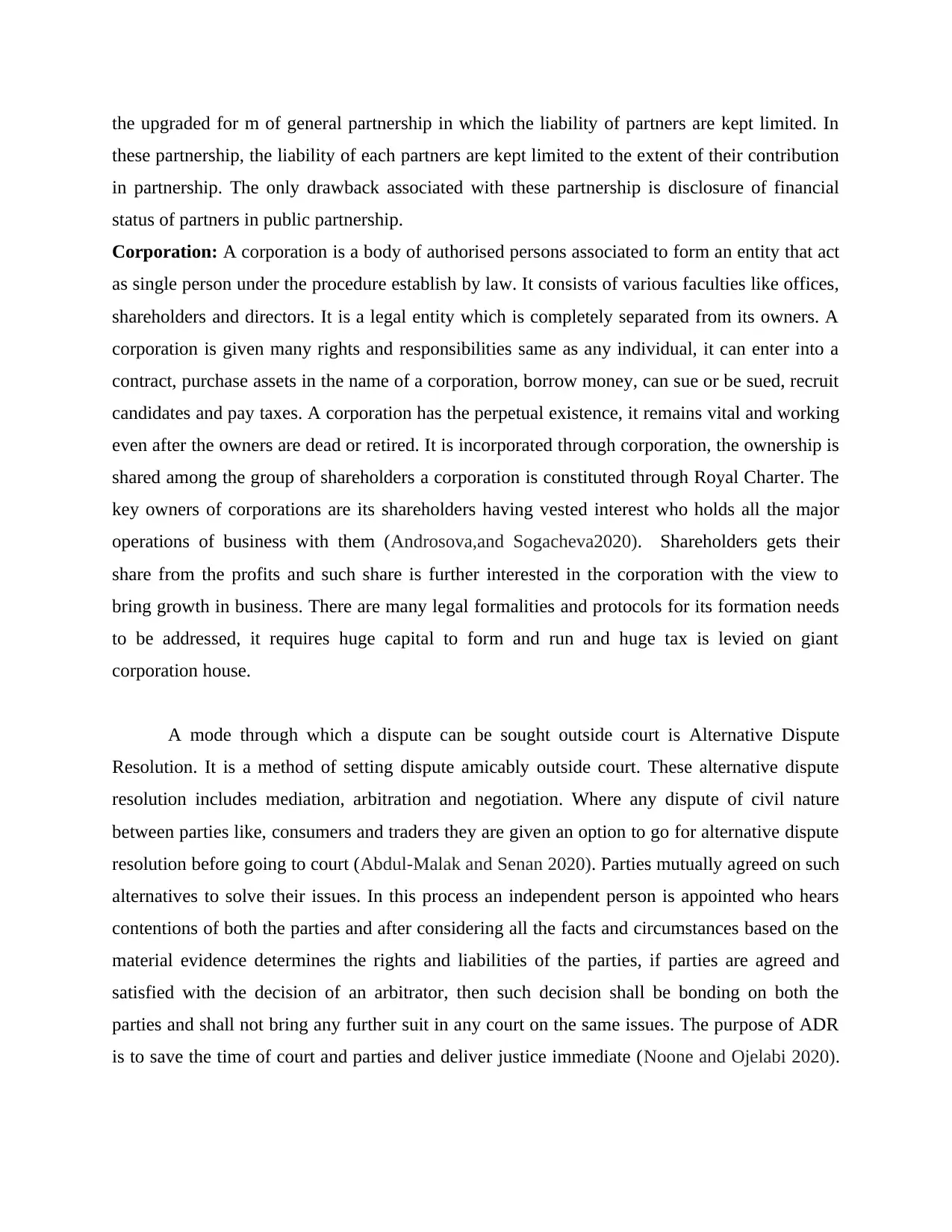
the upgraded for m of general partnership in which the liability of partners are kept limited. In
these partnership, the liability of each partners are kept limited to the extent of their contribution
in partnership. The only drawback associated with these partnership is disclosure of financial
status of partners in public partnership.
Corporation: A corporation is a body of authorised persons associated to form an entity that act
as single person under the procedure establish by law. It consists of various faculties like offices,
shareholders and directors. It is a legal entity which is completely separated from its owners. A
corporation is given many rights and responsibilities same as any individual, it can enter into a
contract, purchase assets in the name of a corporation, borrow money, can sue or be sued, recruit
candidates and pay taxes. A corporation has the perpetual existence, it remains vital and working
even after the owners are dead or retired. It is incorporated through corporation, the ownership is
shared among the group of shareholders a corporation is constituted through Royal Charter. The
key owners of corporations are its shareholders having vested interest who holds all the major
operations of business with them (Androsova,and Sogacheva2020). Shareholders gets their
share from the profits and such share is further interested in the corporation with the view to
bring growth in business. There are many legal formalities and protocols for its formation needs
to be addressed, it requires huge capital to form and run and huge tax is levied on giant
corporation house.
A mode through which a dispute can be sought outside court is Alternative Dispute
Resolution. It is a method of setting dispute amicably outside court. These alternative dispute
resolution includes mediation, arbitration and negotiation. Where any dispute of civil nature
between parties like, consumers and traders they are given an option to go for alternative dispute
resolution before going to court (Abdul-Malak and Senan 2020). Parties mutually agreed on such
alternatives to solve their issues. In this process an independent person is appointed who hears
contentions of both the parties and after considering all the facts and circumstances based on the
material evidence determines the rights and liabilities of the parties, if parties are agreed and
satisfied with the decision of an arbitrator, then such decision shall be bonding on both the
parties and shall not bring any further suit in any court on the same issues. The purpose of ADR
is to save the time of court and parties and deliver justice immediate (Noone and Ojelabi 2020).
these partnership, the liability of each partners are kept limited to the extent of their contribution
in partnership. The only drawback associated with these partnership is disclosure of financial
status of partners in public partnership.
Corporation: A corporation is a body of authorised persons associated to form an entity that act
as single person under the procedure establish by law. It consists of various faculties like offices,
shareholders and directors. It is a legal entity which is completely separated from its owners. A
corporation is given many rights and responsibilities same as any individual, it can enter into a
contract, purchase assets in the name of a corporation, borrow money, can sue or be sued, recruit
candidates and pay taxes. A corporation has the perpetual existence, it remains vital and working
even after the owners are dead or retired. It is incorporated through corporation, the ownership is
shared among the group of shareholders a corporation is constituted through Royal Charter. The
key owners of corporations are its shareholders having vested interest who holds all the major
operations of business with them (Androsova,and Sogacheva2020). Shareholders gets their
share from the profits and such share is further interested in the corporation with the view to
bring growth in business. There are many legal formalities and protocols for its formation needs
to be addressed, it requires huge capital to form and run and huge tax is levied on giant
corporation house.
A mode through which a dispute can be sought outside court is Alternative Dispute
Resolution. It is a method of setting dispute amicably outside court. These alternative dispute
resolution includes mediation, arbitration and negotiation. Where any dispute of civil nature
between parties like, consumers and traders they are given an option to go for alternative dispute
resolution before going to court (Abdul-Malak and Senan 2020). Parties mutually agreed on such
alternatives to solve their issues. In this process an independent person is appointed who hears
contentions of both the parties and after considering all the facts and circumstances based on the
material evidence determines the rights and liabilities of the parties, if parties are agreed and
satisfied with the decision of an arbitrator, then such decision shall be bonding on both the
parties and shall not bring any further suit in any court on the same issues. The purpose of ADR
is to save the time of court and parties and deliver justice immediate (Noone and Ojelabi 2020).
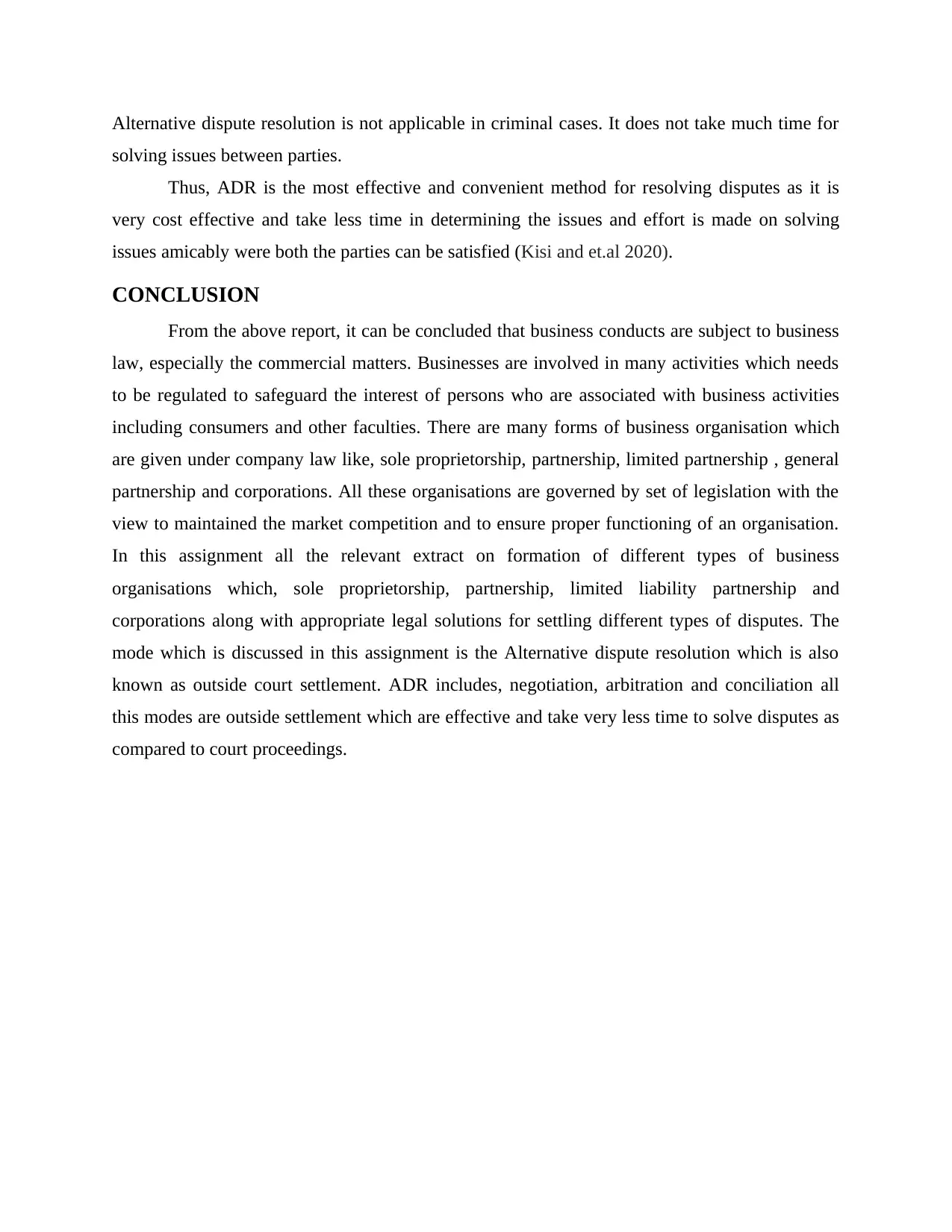
Alternative dispute resolution is not applicable in criminal cases. It does not take much time for
solving issues between parties.
Thus, ADR is the most effective and convenient method for resolving disputes as it is
very cost effective and take less time in determining the issues and effort is made on solving
issues amicably were both the parties can be satisfied (Kisi and et.al 2020).
CONCLUSION
From the above report, it can be concluded that business conducts are subject to business
law, especially the commercial matters. Businesses are involved in many activities which needs
to be regulated to safeguard the interest of persons who are associated with business activities
including consumers and other faculties. There are many forms of business organisation which
are given under company law like, sole proprietorship, partnership, limited partnership , general
partnership and corporations. All these organisations are governed by set of legislation with the
view to maintained the market competition and to ensure proper functioning of an organisation.
In this assignment all the relevant extract on formation of different types of business
organisations which, sole proprietorship, partnership, limited liability partnership and
corporations along with appropriate legal solutions for settling different types of disputes. The
mode which is discussed in this assignment is the Alternative dispute resolution which is also
known as outside court settlement. ADR includes, negotiation, arbitration and conciliation all
this modes are outside settlement which are effective and take very less time to solve disputes as
compared to court proceedings.
solving issues between parties.
Thus, ADR is the most effective and convenient method for resolving disputes as it is
very cost effective and take less time in determining the issues and effort is made on solving
issues amicably were both the parties can be satisfied (Kisi and et.al 2020).
CONCLUSION
From the above report, it can be concluded that business conducts are subject to business
law, especially the commercial matters. Businesses are involved in many activities which needs
to be regulated to safeguard the interest of persons who are associated with business activities
including consumers and other faculties. There are many forms of business organisation which
are given under company law like, sole proprietorship, partnership, limited partnership , general
partnership and corporations. All these organisations are governed by set of legislation with the
view to maintained the market competition and to ensure proper functioning of an organisation.
In this assignment all the relevant extract on formation of different types of business
organisations which, sole proprietorship, partnership, limited liability partnership and
corporations along with appropriate legal solutions for settling different types of disputes. The
mode which is discussed in this assignment is the Alternative dispute resolution which is also
known as outside court settlement. ADR includes, negotiation, arbitration and conciliation all
this modes are outside settlement which are effective and take very less time to solve disputes as
compared to court proceedings.
⊘ This is a preview!⊘
Do you want full access?
Subscribe today to unlock all pages.

Trusted by 1+ million students worldwide
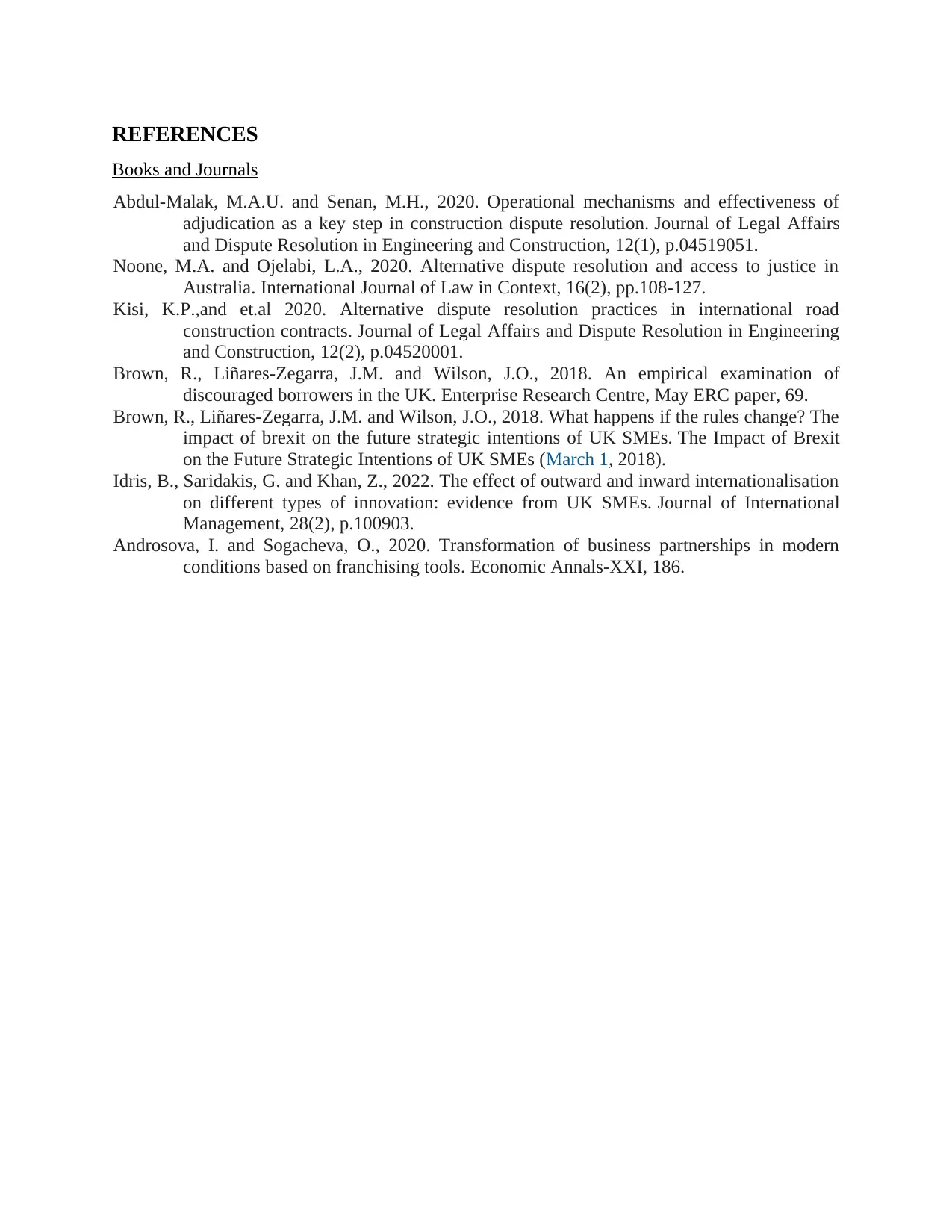
REFERENCES
Books and Journals
Abdul-Malak, M.A.U. and Senan, M.H., 2020. Operational mechanisms and effectiveness of
adjudication as a key step in construction dispute resolution. Journal of Legal Affairs
and Dispute Resolution in Engineering and Construction, 12(1), p.04519051.
Noone, M.A. and Ojelabi, L.A., 2020. Alternative dispute resolution and access to justice in
Australia. International Journal of Law in Context, 16(2), pp.108-127.
Kisi, K.P.,and et.al 2020. Alternative dispute resolution practices in international road
construction contracts. Journal of Legal Affairs and Dispute Resolution in Engineering
and Construction, 12(2), p.04520001.
Brown, R., Liñares-Zegarra, J.M. and Wilson, J.O., 2018. An empirical examination of
discouraged borrowers in the UK. Enterprise Research Centre, May ERC paper, 69.
Brown, R., Liñares-Zegarra, J.M. and Wilson, J.O., 2018. What happens if the rules change? The
impact of brexit on the future strategic intentions of UK SMEs. The Impact of Brexit
on the Future Strategic Intentions of UK SMEs (March 1, 2018).
Idris, B., Saridakis, G. and Khan, Z., 2022. The effect of outward and inward internationalisation
on different types of innovation: evidence from UK SMEs. Journal of International
Management, 28(2), p.100903.
Androsova, I. and Sogacheva, O., 2020. Transformation of business partnerships in modern
conditions based on franchising tools. Economic Annals-XXI, 186.
Books and Journals
Abdul-Malak, M.A.U. and Senan, M.H., 2020. Operational mechanisms and effectiveness of
adjudication as a key step in construction dispute resolution. Journal of Legal Affairs
and Dispute Resolution in Engineering and Construction, 12(1), p.04519051.
Noone, M.A. and Ojelabi, L.A., 2020. Alternative dispute resolution and access to justice in
Australia. International Journal of Law in Context, 16(2), pp.108-127.
Kisi, K.P.,and et.al 2020. Alternative dispute resolution practices in international road
construction contracts. Journal of Legal Affairs and Dispute Resolution in Engineering
and Construction, 12(2), p.04520001.
Brown, R., Liñares-Zegarra, J.M. and Wilson, J.O., 2018. An empirical examination of
discouraged borrowers in the UK. Enterprise Research Centre, May ERC paper, 69.
Brown, R., Liñares-Zegarra, J.M. and Wilson, J.O., 2018. What happens if the rules change? The
impact of brexit on the future strategic intentions of UK SMEs. The Impact of Brexit
on the Future Strategic Intentions of UK SMEs (March 1, 2018).
Idris, B., Saridakis, G. and Khan, Z., 2022. The effect of outward and inward internationalisation
on different types of innovation: evidence from UK SMEs. Journal of International
Management, 28(2), p.100903.
Androsova, I. and Sogacheva, O., 2020. Transformation of business partnerships in modern
conditions based on franchising tools. Economic Annals-XXI, 186.
1 out of 7
Related Documents
Your All-in-One AI-Powered Toolkit for Academic Success.
+13062052269
info@desklib.com
Available 24*7 on WhatsApp / Email
![[object Object]](/_next/static/media/star-bottom.7253800d.svg)
Unlock your academic potential
Copyright © 2020–2025 A2Z Services. All Rights Reserved. Developed and managed by ZUCOL.





